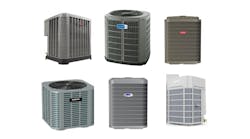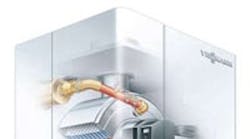By Carol Fey
Condensing boilers are designed to operate at a lower boiler water temperature due to the corrosion resistant stainless steel heat exchanger. Shown at left is the Viessmann Vitodens 200, a wallmounted condensing boiler with a corrosion resistant stainless steel Inox-Radial heat exchanger.
Photos courtesty ViessmanN Manufacturing
Condensing boilers are the newest greatest thing. But what’s so special about them? Do they actually work? And if they condense, what about the old fact that condensation kills boilers?
A condensing boiler can be more efficient than a conventional boiler. In a correctly designed system, it can be 90 to 98% efficient. The catch is that the efficiency doesn’t happen in just any application. The boiler must be able to condense flue gases inside the heat exchanger, and that takes a special circumstance.
What is Condensing?
Condensing occurs when a gas is cooled enough to become a liquid. You see it all the time. The humidity (a gas) in the air becomes water when it’s cooled by the outside surface of a cold drink container. The same thing happens at night when dew appears outside on the grass and windshields. What we don’t see is that heat is given off in the process. Applied to the heating business, this is an exciting event — heat that costs nothing.
In a boiler or furnace, combustion causes flue gases. With a conventional boiler, we want those gases to go right on up the chimney. Allowed to condense in the boiler or flue, they’d result in considerable damage. That’s why it is important to keep return water temperatures high in a conventional boiler.
But if you had a boiler that could withstand the corrosive liquid—called condensate, you could condense the gases, and keep the resultant free heat. That’s exactly what a condensing boiler does. But it doesn’t do it without help from the return water temperature. Low temperature return water is required as a coolant to condense the flue gases inside the heat exchanger.
The Magic (or not) of the Condensing Boiler
Condensation inside the boiler begins when flue gases drop to about 130F. For full efficiency, the temperature in the heat exchanger needs to be 60F or less. Flue gases tend to be about 7F warmer than the return water. This is going to require some cool return water.
Here’s where old industry standards go headto- head with the new technical requirements, and create a problem. From decades-old heating practices we have inherited supply water temperatures: 160F for cast iron radiators, 180F for copper fin tube, and 190F for fan coils.
We also have an industry standard that says that we should aim for a 20F temperature drop (ΔT) from the supply water to the return. If we use 180F supply water, and we have a 20F ΔT, that gives us 160F water returning to the heat exchanger. The flue gases leaving the heat exchanger will be about 167F. The flue gases won’t condense in the heat exchanger, and the expected efficiency won’t occur.
Lower Return Water Temperatures
The only way to get expected efficiencies from a condensing boiler is to deliver lower return water temperatures than are appropriate for conventional boilers. Here are some ways to have lower water temperatures:
1. Do a load calculation (also known as a heat loss calculation).
It wouldn’t be wise to simply lower water temperatures, but a load calculation may show that a lower water temperature than expected can meet the heating needs of the building. After all, buildings are much better insulated and more tightly constructed than they were in the days when those temperature guidelines were developed.
Load calculation software is easy to use, and is available — often at no charge — from original equipment manufacturers (OEMs).
2. Use an outdoor reset control. A way to get low return water temperatures much of the time is to use an outdoor reset control.
Because outdoor temperatures are usually above design temperatures (there are more warmer days than colder ones), outdoor reset can enable condensing 60-70% of the time.
For example, if when the outdoor temperature is 40F, and the boiler provides 125F water., with a 20F ΔT, the return water would be105F. Add 7F (see above) and the flue gas would be 112F. It’s condensing! That would take the boiler from 89% to 92-94% efficiency because of the outdoor reset.
3. Look for ideal applications. Ideal applications for condensing boilers are whenever you can provide low return water temperatures. With the lower design temperatures of in-floor radiant and snow melt, these are perfect targets.
The Bottom Line
Regardless of the high efficiency rating of a condensing boiler, it can’t deliver that energy savings unless flue gases condense in its heat exchanges. That’s where the free heat comes from.
Condensing happens only if a coolant is provided, and that coolant is low temperature return water.
It all depends upon appropriate system design and application.









